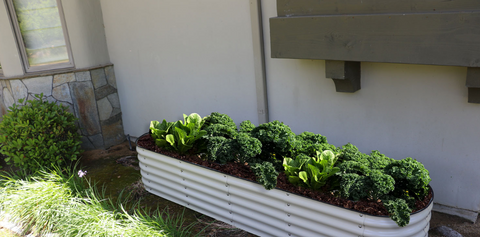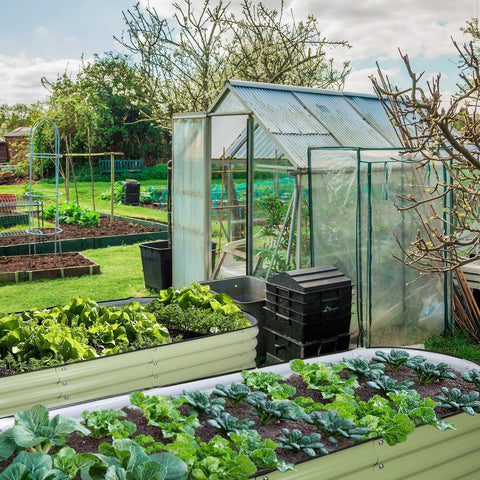Tips from Olle Garden Bed: How to Grow Broccoli
Would you like to grow nutrient-rich broccoli in your own garden beds? Learn how to cultivate broccoli in your backyard vegetable garden.
Broccoli, with its vibrant green florets and abundant nutrients, is a favorite vegetable among gardeners and food enthusiasts alike. Whether you are health-conscious and looking to add nutrient-rich foods to your diet or an avid gardener seeking a versatile and beneficial crop, growing broccoli offers numerous advantages.
Broccoli is not only packed with vitamins, minerals, dietary fiber, and antioxidants, but it is also easy to cultivate in your backyard. By mastering the basic knowledge of broccoli cultivation, you can enjoy the delicious rewards of this wholesome vegetable.

In this guide, we will explore the step-by-step process of growing broccoli, from choosing the right variety to starting the seeds, tending to your plants, knowing when to harvest, and ensuring a successful crop that will grace your table with freshness and nutrition.
About Broccoli
Broccoli (Brassica oleracea var. italica) belongs to the cruciferous vegetable family, which includes cabbage, cauliflower, and kale. This cool-season crop is renowned for its captivating appearance, featuring a cluster of tightly packed florets attached to a thick, edible stem.
The florets are usually deep green, rounded, and commonly referred to as "broccoli heads" or "curds." Broccoli plants can reach a height of 2 to 3 feet, with lush and deeply lobed leaves.
Beyond its appealing looks, broccoli is a nutritional powerhouse, abundant in vitamins, minerals, dietary fiber, and antioxidants.
Originating from the Mediterranean region, broccoli boasts a fascinating history, believed to have been cultivated for thousands of years, with records of its consumption dating back to ancient Roman times.
During the 16th century, broccoli gained popularity in Italy and gradually spread to other parts of Europe, eventually finding its way to the United States. Today, it is widely grown worldwide due to its versatility and remarkable health benefits, becoming a staple in numerous dishes.
Popular Broccoli Varieties to Consider
When it comes to planting broccoli, several popular and recommended varieties are available to choose from. Each variety comes with its own unique characteristics, flavors, and suitability for different climates. Here are some common broccoli varieties you may consider growing:
Romanesco Broccoli, also known as Italian Broccoli, is an heirloom variety with large heads and thick, tender stems. It boasts a mild, slightly sweet flavor, making it a favorite for both raw consumption and cooking. Romanesco thrives in various climatic conditions, particularly in cooler temperatures.
Belstar Broccoli is a hybrid variety renowned for its early maturity and uniform, rounded heads. It has a dense texture and a mild taste with a subtle sweetness. Belstar is an excellent choice for gardeners in colder regions, as it exhibits strong resistance to low temperatures and frost.
Covina Broccoli is a popular broccoli variety with medium-sized heads and tightly packed florets. It features a mildly bitter taste that intensifies when cooked, making it a suitable option for steaming, stir-frying, or roasting. Covina is highly adaptable and can flourish in various climates, including mild and cooler regions.
De Cicco Broccoli is an heirloom variety with smaller heads and a prolonged harvest period. It boasts a mild flavor and tender stems, making it an ideal choice for fresh consumption and freezing. De Cicco is relatively versatile and can thrive in various climate conditions, even in areas with shorter growing seasons.
Fiesta Broccoli is a hybrid variety with medium-sized heads and a beautiful green appearance. It has a mild, slightly sweet taste, making it suitable for both raw consumption and light cooking. Fiesta is well-suited for growing in regions with moderate temperatures and can tolerate some heat.
Waltham Broccoli is a popular open-pollinated variety known for its bluish-green large heads and abundant side shoots. It has a rich and slightly sweet taste, making it a versatile choice for various cooking purposes. Waltham performs well in colder climate conditions and exhibits high tolerance to temperature fluctuations.
These are just a few examples of the numerous broccoli varieties available. Consider your climate, growing season, and personal preferences when selecting the best broccoli variety for your garden.
Planting Broccoli
Now that you've chosen the suitable broccoli variety, let's dive into the planting process. Follow these steps for successful broccoli cultivation:
Choose the Right Time
Broccoli is a cool-season crop and thrives in temperatures between 60°F to 70°F (15°C to 21°C). Plant broccoli in early spring for a spring harvest or in late summer for a fall harvest. Avoid planting during peak summer heat or winter frost.
Prepare the Soil
Broccoli prefers well-draining, fertile soil rich in organic matter. Amend the soil with compost or well-rotted manure before planting to improve its nutrient content and structure. The soil's pH level should ideally be slightly acidic to neutral, around 6.0 to 7.0.
Start Seeds Indoors (Optional)
You can start broccoli seeds indoors about 6 to 8 weeks before the last expected frost date in your area. Use seedling trays or pots filled with seed-starting mix. Sow the seeds about ¼ inch deep, water gently, and provide sufficient light for germination.
Direct Sow in the Garden
Alternatively, you can sow broccoli seeds directly in the garden once the soil temperature reaches around 50°F (10°C) and is workable. Plant the seeds about ½ inch deep and 3 inches apart in rows spaced about 18 to 24 inches apart.
Transplant Seedlings (Optional)
If you started seeds indoors, transplant the seedlings into the garden when they have developed their first true leaves and are around 4 to 6 weeks old. Space the transplants about 18 to 24 inches apart.
Provide Adequate Watering
Broccoli requires consistent moisture throughout its growing period. Water the plants regularly to keep the soil evenly moist but not waterlogged. Avoid overhead watering, as it may encourage fungal diseases. Using a soaker hose or drip irrigation is preferable.

Mulch the Soil
Apply a layer of organic mulch, such as straw or shredded leaves, around the base of the broccoli plants. Mulching helps retain soil moisture, suppresses weeds, and regulates soil temperature.
Moderate Fertilization
Avoid excessive nitrogen fertilizer, as it may lead to excessive leaf growth at the expense of broccoli head development. Apply a balanced fertilizer or compost around the plants once they are established, but refrain from over-fertilizing.
Control Pests and Diseases
Broccoli is susceptible to pests like aphids, cabbage worms, and flea beetles, as well as diseases such as clubroot and black rot. Monitor your plants regularly and take appropriate measures to control these issues. Consider using natural pest control methods whenever possible.
Harvesting Broccoli
Broccoli heads are ready for harvest when they are firm, dark green, and compact. Harvest the main head by cutting the stem just below the head with a sharp knife. Some varieties will produce side shoots after the main head is harvested, providing additional smaller florets for later harvest.
Storage and Preservation
Freshly harvested broccoli can be refrigerated and stored in a plastic bag for up to a week. To extend its shelf life, blanch the broccoli and freeze the florets for long-term storage.
By following these steps and tending to your broccoli plants with care, you can enjoy a bountiful harvest of this nutritious and delectable vegetable. Happy gardening!
